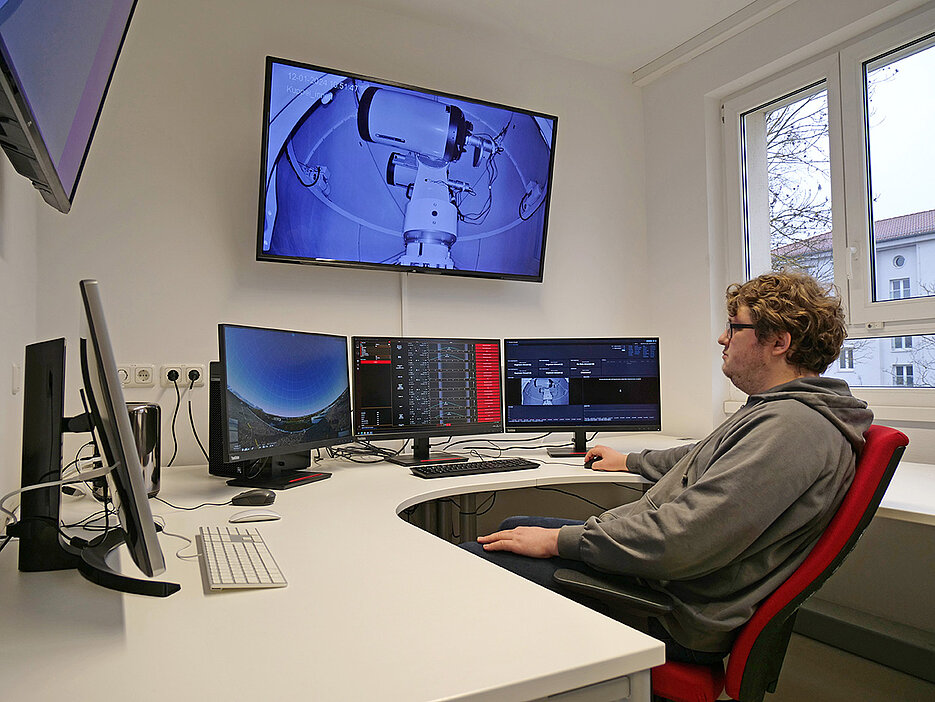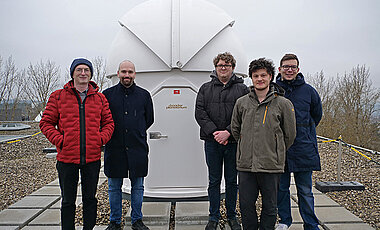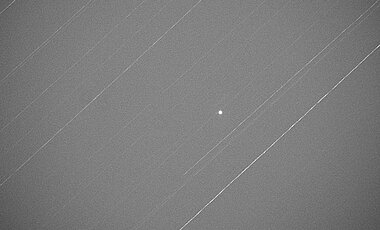New Telescope for Student’s Satellite Project
01/25/2024A dome around three metres high sits enthroned on the roof of the Geography building on the Würzburg Hubland Campus. It contains a telescope that students are using to develop an intelligent sensor for satellites.

A new telescope has been in operation on the Hubland Campus of Julius-Maximilians-Universität (JMU) Würzburg since January 2024. A team of students is using it to develop AI algorithms for small satellites in order to prevent collisions with space debris in orbit more efficiently than before. The long-term goal is for the satellites to be able to recognise impending collisions independently using intelligent optical sensors and avoid them autonomously. The Federal Ministry for Economic Affairs and Energy is funding the KI-SENS project with a good 500,000 euros.
What Characterises the New Telescope
The telescope is located on the roof of the Geography building on the Hubland Campus. "It is able to follow the trajectory of even smaller objects particularly quickly and precisely," explains Hakan Kayal, JMU Professor of Astronautics. This is why the dome can also be opened completely – with slower telescopes it is only open a slit wide and rotates completely.
The remote control for the telescope is located in two places on campus: firstly, in the mission control centre of Hakan Kayal's professorship, where also other telescopes and satellite missions are controlled. Secondly, in the rooms of the student association WüSpace e.V. in which Würzburg students of aerospace informatics are organised; 20 of them are working on the KI-SENS project.
Transfer From the Telescope to a Satellite
What are the students doing with the new telescope? They are using AI algorithms to teach it to recognise small moving objects in the sky and predict their trajectory so that it can track them. "To do this, we set up a conventional object detection system and, in parallel, a second one based on AI," explains Master student Maximilian Reigl.
The algorithms are then transferred to a satellite sensor. Eventually, a sensor prototype will be built and tested in a test laboratory. The plan is to complete this work by the end of 2024. "If we prove that the AI sensor is highly likely to work in orbit, the next step would be a real space test," says the aerospace informatics student.
Evasive Manoeuvres Previously Controlled Manually
If everything works out, we could end up with an innovation from Würzburg that means greater safety for satellites and manned space travel. This is because the risk of collisions with space debris is high and continues to grow, as the European Space Agency (ESA) emphasised in a report published in 2023.
"The USA maintains a large and dense observation network with which it predicts and reacts to possible collisions with space debris on a daily basis. ESA is currently building such a network," says Hakan Kayal. Until now, the necessary evasive manoeuvres have been controlled manually by humans. In the case of the International Space Station ISS, this is necessary several times a year. The manoeuvres are time-consuming, increase fuel consumption and also increase the risk of colliding with other objects when leaving the flight path. An intelligent sensor that can perform these manoeuvres autonomously would be a significant step forward.
Young Talent for Space Technology
The special thing about KI-SENS is that the work on the project is being driven forward largely independently by JMU students organised in the WüSpace association. They are supported by Professor Kayal and project manager Tobias Herbst. In this way, the students familiarise themselves with the process of a development project in space travel from A to Z.
The increased participation of students in small satellite programmes is very important to the Federal Ministry of Economics as a funder, as Hakan Kayal explains: "The aim is to further increase the attractiveness of the subject in terms of recruiting young talent."
Funding for Other Projects Too
The German Space Agency at the German Aerospace Centre (DLR) is funding the KI-SENS project with funds from the Federal Ministry of Economics and Climate Protection (BMWK; funding reference 50RU2227).
KI-SENS is not the only DLR-funded project at Hakan Kayal's professorship that is endeavouring to achieve greater autonomy in space travel with the help of artificial intelligence. Another is the SONATE-2 space mission; this small satellite is expected to be launched into orbit by a rocket from the USA at the beginning of March 2024.
Weblinks
Student association WüSpace e.V. https://www.wuespace.de/
Contact
Prof. Dr. Hakan Kayal, Space Technology, Institute of Computer Science, University of Würzburg, T +49 931 31-86649, hakan.kayal@uni-wuerzburg.de
Student association WüSpace e.V., kontakt@wuespace.de








